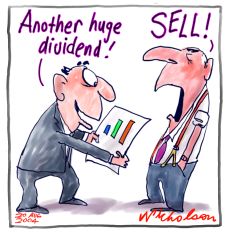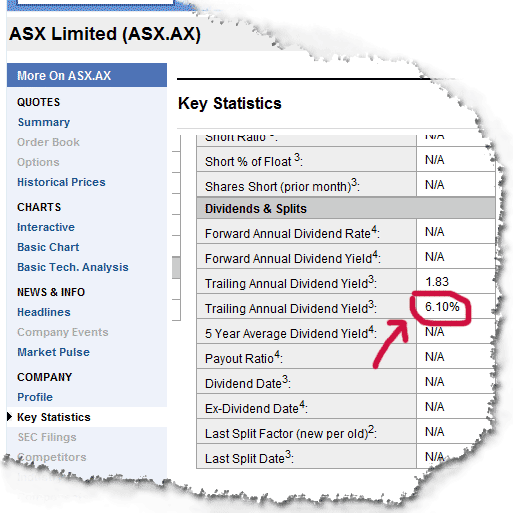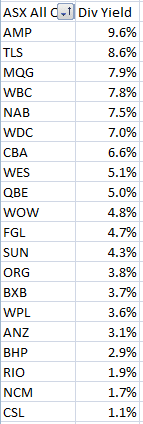
Lately my portfolio has become a mixture of three types of stocks.
1. Long term stocks (these make up the bulk of my portfolio)
2. Short term stocks (because they can be fun although I don’t hold as many of these at the moment)
and
3. Dividend stocks (I’m gradually buying more and more of these).
Over the past few years I’ve become more and more keen about investing for the dividend since you basically get paid whether the company share price rises or not. So it’s the perfect strategy for a jumpy or flat market (like now).
Dividend investment strategies are not new and many of my long-term shares pay fairly decent dividends anyway but more and more I’ve been choosing companies based on whether they pay a good dividend yield or not.
Dividend Yield
The dividend yield (or interest rate if you prefer) is similar to a the interest rate on a bank account in that you get an equivalent payout twice per year (in most cases) depending on the value of the stock that you hold.
Most Australian’s are used to seeing it in terms of ‘cents per share’ but I prefer to look at it in terms of yield so that I can easily compare two different companies or see at a glance what payout they give.
For example here is the dividend yield for ASX:

Image Screenshot taken from Yahoo! Finance
It’s a pretty good yield at 6.1% (which means that you’ll get the equivalent of 6.1% in annual interest if you held ASX during both dividend periods).
You can find the div yield at a few different websites, but I usually just check it out on Yahoo! Finance because it’s free.
Oh and in case you were wondering:
Forward Annual Dividend Yield takes into account the future dividend payout’s (either from forecasts or if the company has announced its next dividend payout) and Trailing Annual Dividend Yield is based on the dividends that have already been paid out over the past year.
What Is A Good Dividend Yield?
You’ll hear many investors saying that they want a double-digit yield (anything from 10% p.a. and above). And while that would be an awesome yield, I’m a bit more conservative.
I consider anything around about 5% to be a good yield and above 7% to be great.
Usually you want to choose a company that pays a rate higher than you can get at the online savings accounts. ING Direct’s Savings Maximiser (Australia’s most popular online savings account) currently pays 4.75% so anything above this would be considered good in my opinion.
So it seems now that the most likely thing to do would be to go and search all of the companies listed on the stock exchange for the highest dividend yield right?
Well no, hold on.
Getting a good yield is important, but you still need to make sure that the company you invest in is sound.
Sooo, generally I still look at the other fundamentals first.
Now I am a bit more lenient with some of the fundamentals when looking for good dividend stocks but they still need to be close to my rules as much as possible.
It’s even better if they fit all of the rules.
In fact I just wrote a post of the top eight shares to invest into in Australia and included their dividend yields as well.
And boy did I find a few good dividend stocks!
Like:
* SGT – Singapore Telecommunications with a brilliant 8.3%
* CBA – Commonwealth Bank with an awesome 6.9%
* and my sentimental favorite ORL – Oroton with 5.9%
What Are The Best Dividend Shares In The ASX20?
While I like the above three div stocks, you might want to start (or are just curious) what the highest paying dividend paying companies in the ASX20 is.
Well here they all are listed from highest div yield to lowest:

Oooh check some of those out. AMP is nearly in double digits with a nice 9.6% so might be a great pick (although Telstra TLS has the better financials and still has an outstanding 8.6% yield). No wonder Telstra is one of Australia’s favorite shares to own.
So Should You Re-invest Your Dividends or Take The Cash?
Ok, so you’ve decided that dividend stocks seem like a good deal but you are then offered a dividend reinvestment plan from the company. Do you take it?
Depends on whether you need the cash or not.
If you don’t, then reinvesting your dividends back into the company is a wise move, and here is why:
As you know, you get paid out your divs depending on how many shares you own in the company. So it makes sense then that the more shares you own, the more dividends you’ll get.
And if you are reinvesting those dividends back into more shares then next time around you’ll get paid more dividends because you hold more stock. And so on and so on.
It’s compounding interest at it’s best.
Can it get any better?
Yes it can!
Because if you’ve chosen strong stable companies to begin with then over the long-term they should increase in value. (And yes, generally MOST companies will rise in price over the long-term).
And as they start to increase in value, as you hold more shares (because you are reinvesting them) your portfolio will be worth more.
And the cycle goes on and on.
And you make more and more money. Ahh don’t you love compound interest!
Well I guess I’ve blabbered on enough about how much I’m loving investing for the dividend so it’s time to finish up this post and leave it back over to you to consider investing in some div stocks of your own.
To a happy and profitable 2012!
Tracey 🙂



1 Comment
Hi Tracey
Hope you are well. Just want to get your views on what shares be it International or Australian or EFT I should buy for my newly born granddaughter as I have decided to give her $1,000 and would like to invest for a long term.
I am a pensioner and hence I hope I am not taxed. I do have some shares of my own but so far I have not paid any tax on my shares probably because I have not made any gains but losses.
Your advice would be much appreciated.
Cheers
Thank you
Seemawathie Bhaskaran